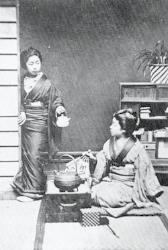
Japanese Village, Knightsbridge
Encyclopedia

Knightsbridge
Knightsbridge is a road which gives its name to an exclusive district lying to the west of central London. The road runs along the south side of Hyde Park, west from Hyde Park Corner, spanning the City of Westminster and the Royal Borough of Kensington and Chelsea...
, London, was a late Victorian era
Victorian era
The Victorian era of British history was the period of Queen Victoria's reign from 20 June 1837 until her death on 22 January 1901. It was a long period of peace, prosperity, refined sensibilities and national self-confidence...
exhibition of Japanese culture located in Humphreys' Hall, which took place from January 1885 until June 1887.
Description
The exhibition employed around 100 Japanese men and women in a setting built to resemble a traditional Japanese village. The exhibition was a commercial venture organised by Tannaker Buhicrosan, who had been organising travelling Japanese exhibitions in Britain for several years beforehand. As a result of the opening up of Japan to trade with Britain in the 1850s, an English craze for all things Japanese had built through the 1860s and 1870s, fed by the British perception of Japan as a mediaeval culture. This resonated particularly with devotees of the Aesthetic movementAestheticism
Aestheticism was a 19th century European art movement that emphasized aesthetic values more than socio-political themes for literature, fine art, the decorative arts, and interior design...
of the late nineteenth century and made the exhibition very popular, with over 250,000 visitors during its early months.
The exhibition was completely contained within Humphreys' Hall (which was south of Knightsbridge and east of what is now Trevor Street including segregated sleeping accommodation for the employees. According to advertisements placed in the Illustrated London News
Illustrated London News
The Illustrated London News was the world's first illustrated weekly newspaper; the first issue appeared on Saturday 14 May 1842. It was published weekly until 1971 and then increasingly less frequently until publication ceased in 2003.-History:...
, "Skilled Japanese artisans and workers (male and female) will illustrate the manners, customs, and art-industries of their country, attired in their national and picturesque costumes. Magnificently decorated and illuminated Buddhist temple. Five o’clock tea in the Japanese tea-house. Japanese Musical and other Entertainments. Every-day Life as in Japan".
While Gilbert and Sullivan
Gilbert and Sullivan
Gilbert and Sullivan refers to the Victorian-era theatrical partnership of the librettist W. S. Gilbert and the composer Arthur Sullivan . The two men collaborated on fourteen comic operas between 1871 and 1896, of which H.M.S...
were writing their opera The Mikado
The Mikado
The Mikado; or, The Town of Titipu is a comic opera in two acts, with music by Arthur Sullivan and libretto by W. S. Gilbert, their ninth of fourteen operatic collaborations...
(1885), W. S. Gilbert
W. S. Gilbert
Sir William Schwenck Gilbert was an English dramatist, librettist, poet and illustrator best known for his fourteen comic operas produced in collaboration with the composer Sir Arthur Sullivan, of which the most famous include H.M.S...
visited the exhibition and engaged Japanese people from the village to teach his cast aspects of Japanese behavior. In May 1885, the hall burnt down overnight and one of the Japanese employees was killed in the blaze. However Mr Buhicrosan immediately announced that the hall and the exhibit would be rebuilt as quickly as possible. As it happened the exhibit employees were already committed to visit Berlin and appear at the 1885 International Hygiene Exhibition in Berlin. They proceeded to fulfill the engagement. Meanwhile the hall and the village exhibit were both reconstructed and the exhibition re-opened to the public in December, 1885.
The exhibition continued for another eighteen months. By February 1887, over a million people had visited it. It closed in June 1887.

